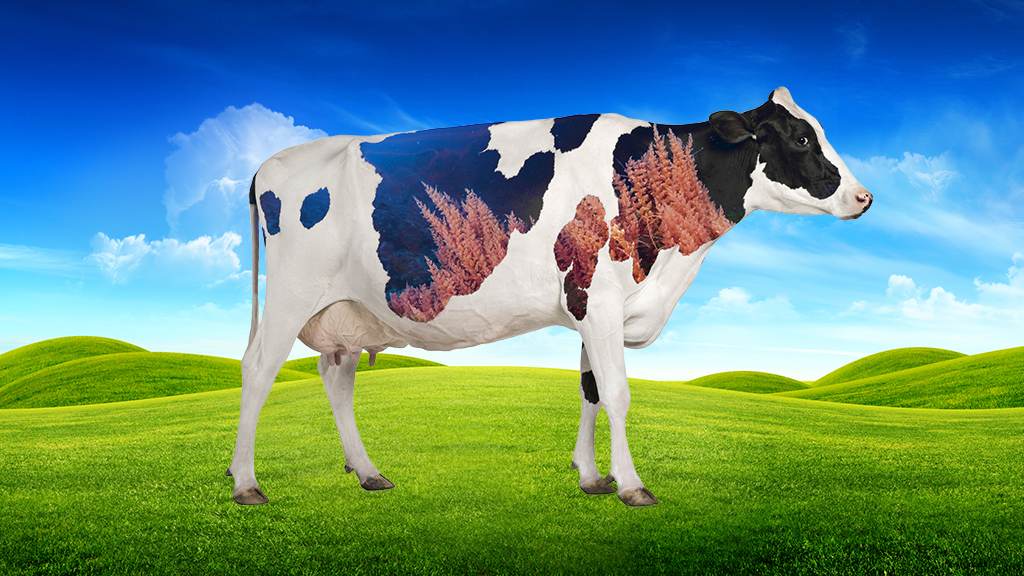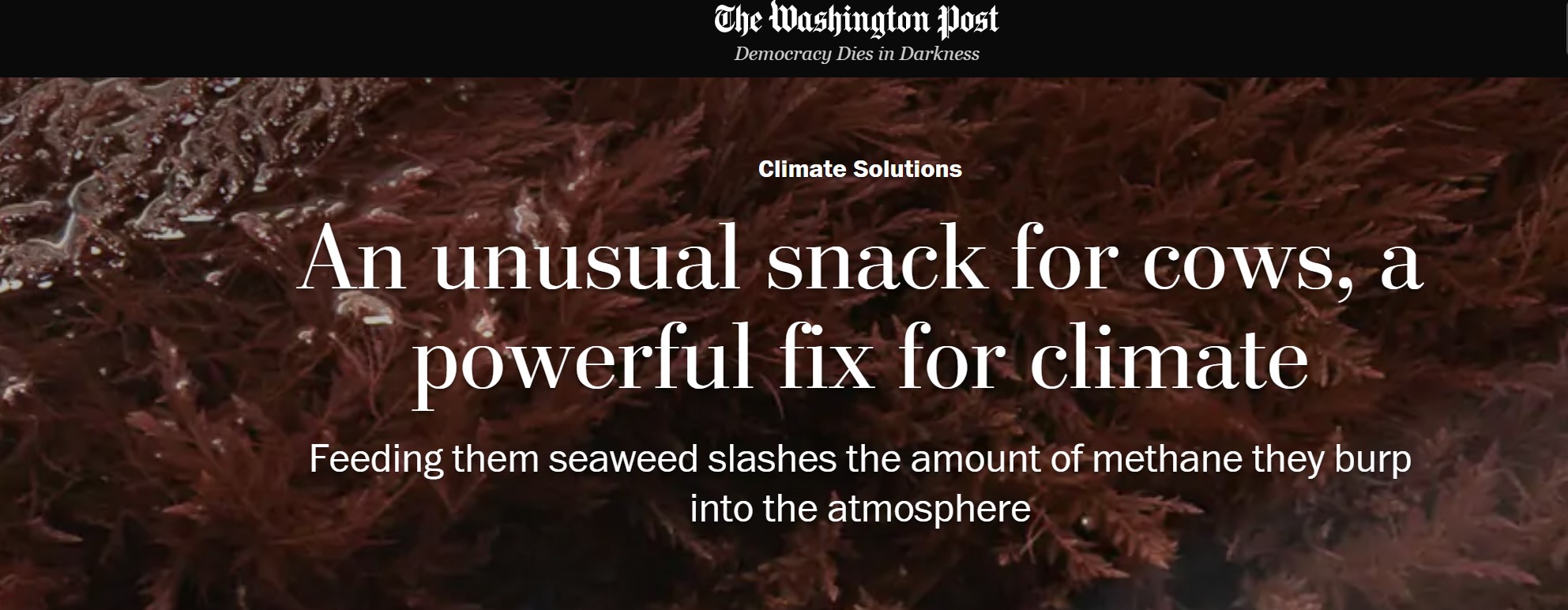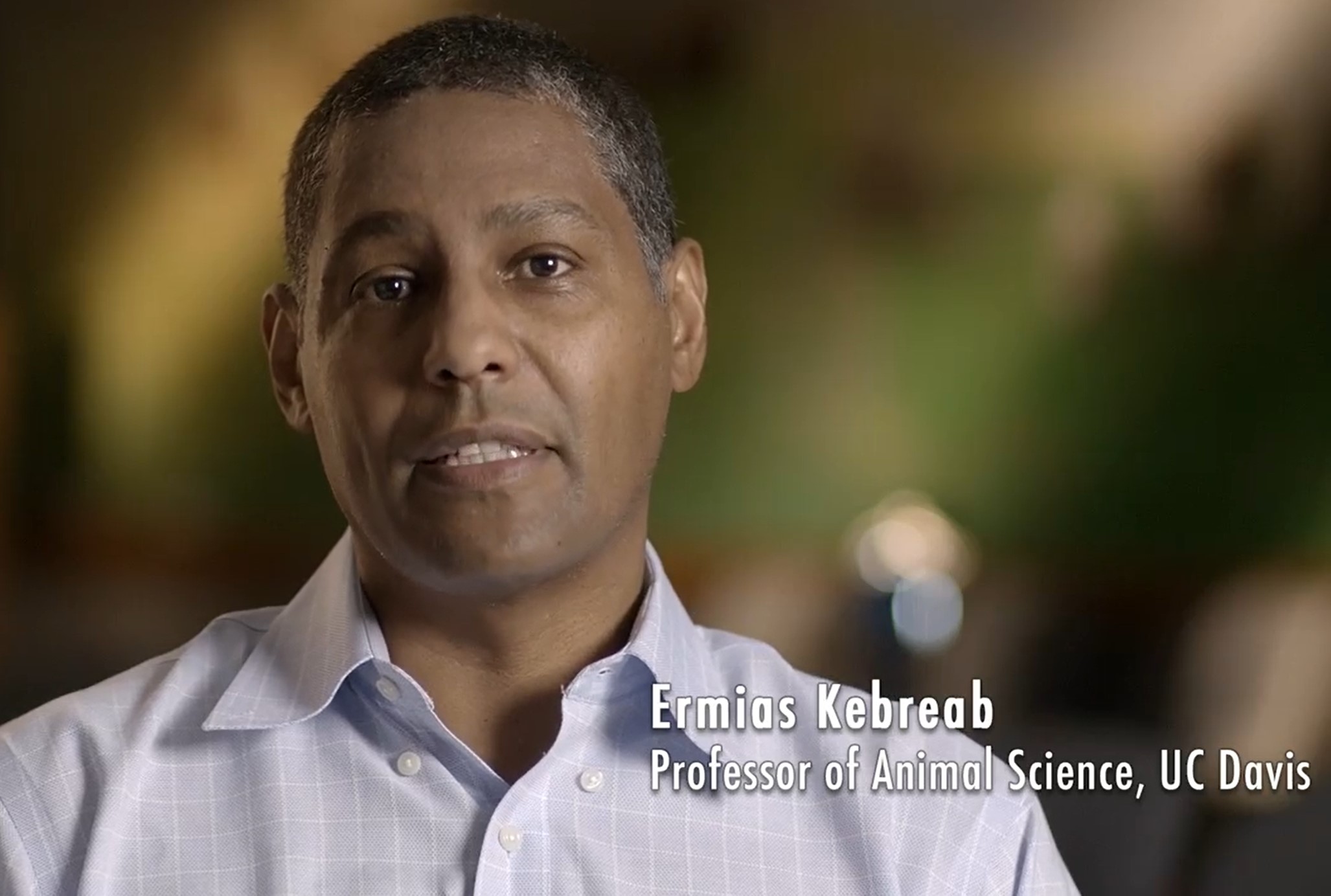Middle School | Daily Do
How Can a Cow's Diet Affect the Climate?

Climate Change Crosscutting Concepts Disciplinary Core Ideas Earth & Space Science Is Lesson Plan Life Science NGSS Phenomena Science and Engineering Practices Three-Dimensional Learning Middle School Grades 6-8
Sensemaking Checklist




Introduction
Many different factors are contributing to the increase in Earth’s average global temperature. One of these factors is the release of the greenhouse gas methane to the atmosphere by certain kinds of animals. Cows, for example, burp methane gas as a natural part of digesting their food. As scientists search for ways to reduce the rate of climate change, some are investigating how feeding cows a kind of seaweed called Asparagopsis can help to reduce the amount of methane in their burps.
View the How can a cow's diet affect the climate? NGSS table to see the elements of the three dimensions targeted in this lesson.
Materials
- Our Beautiful Planet: The Climate Secrets of Cows film
- “An unusual snack for cows, a powerful fix for climate” (article)
- Whiteboard or poster paper and markers
- “Why Do I Burp?” (article)
- Feeding cows a small amount of seaweed can have a big impact on the planet (video)
Links to the articles and videos listed above can also be accessed through the How does a cow's diet affect the climate? collection of resources.
Students' Question Phenomenon
Tell students that you read an interesting article this morning and you want to share it with them. Project the headline below, and have students read it.
- Students = Observe the headline, “An unusual snack for cows, a powerful fix for climate—Feeding them seaweed slashed the amount of methane they burp into the atmosphere,” then share initial thinking about the headline with a partner.
- Teacher = Move around the room and encourage students to record any questions that arise from reading the headline and/or listening to their partner’s ideas.

Have student pairs share their questions with the class. Student questions could include the following:
- Do cows really eat seaweed?
- How could seaweed affect burps?
- What is methane?
- How could what we feed cows fix climate?
Tell students that cows have been around for a very long time. Ask students, “In what ways do humans depend on cows?” The goal here is to get students thinking about all the ways humans depend on cows.
- S = Students share examples of how humans depend on cows.
- T= Remind students that not all people depend on cows in the same way; for example, some students may not eat meat or dairy products. If necessary, make clear to students this is not a debate about the ways some people depend on (or don’t depend on) cows; they are only making a list of how humans currently depend on cows.
Students’ ideas will vary. But they may say that humans depend on cows for food (milk, meat, and other products like cheese), leather goods, and as work animals.
Next, ask students, “Why do you think cow burps would be a problem now, especially since cows have been around for thousands of years?”
- S = Share ideas with the class.
- T = If only a few students volunteer to share ideas, ask them to turn and talk with a partner or small group, then pose the question again.
Students’ ideas will vary, but students will likely focus on the idea that there are more people on Earth and more people means more cows (and more cow burps).
Ask students to think about the questions they have, and ask, “What do you think we need to figure out first to explain how feeding cows seaweed reduces the amount of methane they burp into the atmosphere?”
- S = Share investigation ideas and/or information they need to explain the phenomenon.
- T= As students share, focus the class on ideas shared about figuring out what a burp is and how it can affect the Earth’s climate.
Investigate
To figure out what a burp is, have students start by figuring out something they are familiar with: a human burp. Ask them to recall times when they’ve burped or been with someone else who burped. Divide students into small groups, and have them discuss the following prompts:
- What is a burp?
- Is there any food or drink that makes you burp?
- Why do you burp?
- How do you feel before and after you burp?
- S = Share with group members personal experiences with burps/burping.
Provide each group of students a whiteboard (or poster paper) and markers, and ask them to develop a model to explain what they think happens inside their body to produce a burp and what happens to the burp when it leaves the body.
- S = Create a group consensus model that explains how our body produces a burp and what happens to the burp when it comes out.
- T = Use student models to quickly assess what students currently understand about burps.
Have students share their model and ideas during a whole-class discussion. Student models may represent some of the following ideas:
- A burp is an air bubble that comes from your stomach.
- You burp out gases that are in the foods you eat or drink (soda, for example).
- You burp when you drink or eat too fast and swallow lots of air.
- My friend can swallow air and burp out words.
Explain to students that we burp when our body needs to get rid of excess gas in our stomach. Burps are usually caused by swallowing air (gas) when eating or drinking. Extra gas can also be produced as part of the digestive process and can also be released as a burp.
Next, ask students to brainstorm ways humans can avoid having excess gas in their stomachs.
- S = Work with group members to brainstorm ways humans can avoid the need to burp.
- T = Move from group to group, and if necessary, help facilitate discussion by sharing one or more of the following prompts: What types of food or drink (other than soda) cause you to burp more than others? Have you or someone in your family ever taken medicine to reduce the amount of gas in their stomachs?
Have students share their ideas with the class; record all ideas in a common space. Student shares could include the following:
- Avoid eating specific spicy or hot foods that make them burp.
- Take medicines (antacids) like Tums®, Rolaids®, GasX®, etc., to reduce gas.
Acknowledge that students have produced a lot of good information about burps. Then point out one question about human burps that hasn’t been answered yet: What gases do humans burp? (Do we burp methane?)
Have students read the article “Why Do I Burp?” to figure out what gases human burps contain.
- S = Read “Why Do I Burp?”
- T= This article is short and has a read-aloud feature built in. The article does not discuss specific scientific processes, but does identify some of the gases that human burps contain.
Next, summarize for students that burping is something that happens naturally. Some foods and drinks can make our stomachs produce more gas than others, and products are available that reduce the amount of gas produced when we digest our food. Most of the time our burps contain nitrogen, oxygen, and carbon dioxide.
Return to the headline and read it aloud to students. Ask students which questions we can now answer.
- S = Identify questions the class can now answer (and share the answers).
- T = Use a check mark or other system to show which questions the class has answered. Consider recording the answers the students share on the class’s list of questions.
Ask students what else they need to know to explain this headline. As students share their ideas, focus their attention on ideas shared about needing information about what’s in cow burps, evidence that feeding cows seaweed makes them burp less, and how reducing the amount of methane in the air might affect the Earth’s climate.
Tell students you have a film you would like them to watch that shares information about research on feeding cows seaweed and how methane affects Earth’s climate. Play Our Beautiful Planet The Climate Secrets of Cows.
- S = Record information that can help explain how feeding cows seaweed reduces the amount of methane they burp into the atmosphere.
- T= Consider showing the film in short segments to allow students time to record information. You may want to replay parts of the film that share information about methane and how methane gas in the atmosphere affects Earth’s climate.
Have students return to their small groups and discuss the following questions:
- What is methane gas, and how does it affect the climate?
- Why would scientists be concerned about cow burps?
Bring students back together. Ask the groups to share their answers to one or both of the questions. Create a class record of information shared. Students will likely share the following information obtained from the film:
- Methane gas is produced when a cow digests food.
- Methane gas is released when the cow burps.
- Methane gas is a greenhouse gas and is found in the atmosphere.
- Because there are so many cows, more methane is being released into the air than in the past, and this is causing a problem.
- Scientists think that adding seaweed to a cow’s diet helps reduce the amount of methane gas they burp.
- Scientist have conducted an investigation to gather data about the amount of methane cows produce when they eat seaweed.
Present the data shared in the film to students. Screenshots from the film and the published results are shown below. The data is also shared in the How does a cow's diet affect the climate? collection of resources.
- S = Work with group members to identify patterns in data presented in the bar graph Results (with A. Armata) and line graph Beef Cattle-Davis, CA, and patterns between the two data sets.
- T = Move from group to group prompting students to identify patterns in the data. You might ask, "What pattern(s) did Dr. Kebreab notice in the data represented in the graphs?" and/or "How do the patterns in the data (and between data sets) help support (or refute) the claim that feeding cows seaweed reduces the amount of methane they burp?"
Bring the students back together. Ask the groups to share the patterns they noticed in each data set and between the two data sets. Students should recognize a cause-and-effect relationship between the amount of seaweed in the cows’ diets and the amount of methane gas the cows release.
Reflect
Now that students have learned more about methane gas and how it is related to both cows and climate, ask them to develop a model that explains the headline: “An unusual snack for cows, a powerful fix for climate—Feeding them seaweed slashed the amount of methane they burp into the atmosphere.”
Before students develop their model (individually or in small groups), collaboratively create a list of components the models should include. This “must-have” list of components should include cows, cow stomach (representation of cow stomachs does not need to be scientifically accurate), seaweed, methane gas, and the atmosphere.
- S = Develop a model to explain how feeding cows seaweed reduces the amount of methane they release to the atmosphere, which in turn affects the Earth’s climate. Use words, pictures, and/or symbols to represent components and interactions among components.
- T = Encourage students to create a “before-and-after” model. This way, students can explain what is happening when the cows eat a traditional diet versus a diet that included seaweed.
Look for student models to include the following:
- Methane is produced when cows digest the food they eat.
- Cows burp methane into the atmosphere.
- Many more cows are living on the planet than in the past, which has caused an increase in the amount of methane in Earth’s atmosphere.
- Methane is a greenhouse gas that traps heat in the atmosphere.
- Some cows are eating a diet that includes small amounts of seaweed. The seaweed reduces the amount of gas a cow’s stomach produces (similar to when humans take Tums®, Rolaids®, and other antacids).
- Reducing the amount of methane in the atmosphere could help decrease the rate of climate change.
End the lesson by having students use their models to share ideas about how human actions can negatively and positively affect the Earth’s climate. Ask students, “Besides feeding cows seaweed, what other actions can we take to help reduce the amount of methane in the Earth’s atmosphere?” Students’ answers will vary, but should include the idea that we could limit our use/dependence on animal products; less dependence on cows would cause the number of cows on the planet to decrease (over time), which would decrease the amount of methane released to the atmosphere.
Note: Depending on when in a unit/curriculum this lesson is taught, the modeling task could be used to assess student understanding about how food moves through a series of chemical reactions in which it is broken down and rearranged to form new molecules, to support growth, or to release energy (LS1.C Organization for Matter and Energy Flow in Organism).
To continue learning about this topic, visit the Our Beautiful Planet page on the NSTA website.
Meet Ermias Krebeab

Ermias Kebreab is associate dean for global engagement in the College of Agricultural and Environmental Sciences at the University of California at Davis (UC Davis), as well as director of its World Food Center. He is a renowned scholar and skilled administrator with extensive experience in sustainable agriculture and animal science. Kebreab oversees the advancement of the college's international goals while working in collaboration with extensive internal and external partnerships to solve the grand challenges facing our global food systems. Kebreab also holds the Sesnon Endowed Chair in the Department of Animal Science. He has conducted extensive research in developing strategies for using feed additives to reduce methane emissions from livestock and has authored more than 250 peer-reviewed publications. He chairs the United Nations Food and Agriculture Organization Technical Working Group on Methane, is a committee member on the National Academy of Sciences Panel on Nutrient Requirements of Dairy Cattle, and is a contributing author on the Intergovernmental Panel on Climate Change committee refining guidelines for accounting methane emissions from livestock. Hailing from the East African nation of Eritrea, Kebreab received his B.S. in biology from the University of Asmara, followed by an M.S. in integrative biology and a Ph.D. in ecological modeling from the University of Reading in the United Kingdom. He has previously served as the associate vice provost of Academic Programs for Global Affairs and as the deputy director of the Agricultural Sustainability Institute at UC Davis.
About the Our Beautiful Planet Film Series
This lesson is based on information provided in the film Our Beautiful Planet: The Climate Secrets of Cows. Our Beautiful Planet is a fascinating new series of films that highlight the work that climate scientists around the country are doing to solve some of the world’s most pressing issues. These dedicated researchers are seeking to better understand the many different ways we are being impacted by our changing climate and determine the ways we can most effectively respond. Using cutting-edge technology and innovative problem-solving strategies, they sometimes find their answers in surprising and unexpected places. Our series, by enabling viewers to experience firsthand some of the most important field work being done today, takes science out of the classroom and puts it right into the world. These compelling stories will not only teach our viewers crucial scientific principles, but will also inspire them to use science to examine the issues that confront them in their own communities. Through these films, we hope scientists and citizens alike can come together to safeguard our environment and to protect our beautiful planet. The films are produced by Kikim Media. Support is provided by Kennebunkport Climate Initiative.



